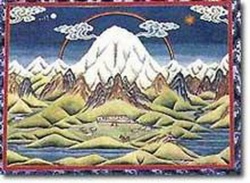Memories and Subtle Impermanence by Peter Morrell
Memories and Subtle Impermanence
by Peter Morrell
When I think back to those dear people who I loved as a child, and who are now gone forever from our midst, swallowed up by the mists of time, I somehow wonder if they ever truly existed or whether it was some dream I still cannot shake from my head some 45 years later. And that in truth it might as well have been a dream. It seems like a dream now and might just be a lingering illusion. It has taken on the nature of a dream, which, just like drifting smoke, will eventually disperse and be gone just as if it never had been. Thus it is like any dream or memory of any person who has ever lived, whether they were alive yesterday or in Roman times. This first point raises the question of what differences, if any, exist between a dream and reality, and hence the intrinsic nature of each.
I used to think of my now-departed dear friends and relatives and was depressed that in truth I will never ever see them again. And equally depressing is the thought therefore that it might have been better had they never existed at all; or that love for others is unjustified and misplaced as it only leads to sorrow. And at times that thought still invades one's entire being and makes one sad at a very deep level, almost as if life has been designed that way intentionally as a form of punishment just for being here. It also seems depressing when you multiply this fact millions of times for everyone on earth, and indeed, for everyone who has ever lived, and whoever will live. Yet this impermanence is part of the structure of reality. Wild as it sounds, that is how one sometimes feels when one reviews the actual facts of who was where and when and how, for now, they are all gone. It is a strange puzzle my mind goes back to very frequently, like a dog going back to chew at an old bone. The Buddhist view of separation and loss is undoubtedly to see it as a lesson in impermanence, but is it more than that?
Like a dream, a vision, a chimera: something not real, faintly glimpsed, a fading memory. Yet with deep emotional roots in our being. It goes to the very root of our heart because we hold so dear those now-departed souls we loved and those who loved us. But I have gradually realised that this subject can form a useful meditation, and a way ordinary life can be brought into the spiritual path. Such a meditation on impermanence and the general flow of events in one's life can be used on a very personal basis for confirming and discovering deep spiritual truths. Indeed, by never deviating from meditation upon the coarse and subtle impermanence of the world, we follow the 'guiding star' of Buddhist practice.
On a certain level, Buddhism encourages us to remove the dead baggage and clutter we carry round with us in our minds and in our lives, and to dispense with all ideas about past and future, so as to blissfully and serenely dwell in this subtle 'now', or eternal moment. Yet its philosophy also encourages us to contemplate the gross and subtle impermanence of the world, in order to gain direct personal insight into the fluid nature of reality and the fundamentally illusory nature of our existence. Without that direct insight, arguably, we do not very profoundly and subtly grasp the deep meaning of emptiness, and thus can never come very close to grasping the nature of enlightenment.
Maybe the best we can do with regard to departed loved-ones is to convince ourselves of the certainty and power of love and that those who we once held so dear will be dear to us again and again in future lives, as they must have been many times in 'times past'. There is some comfort in that view. This can then be used to subdue our nostalgia and cool our yearning, allowing us to remain largely focused in 'times present'. But the emotional power of one's love for those now departed can be forged into a powerful instrument with which to view this illusory and impermanent world we live in. By dwelling upon the personal facts, known intimately and by watching for all manifestations of coarse and subtle impermanence in the world around us, we are able to follow the wisdom of old sages and confirm for ourselves the fundamental truth of Buddhist logic.
Observing coarse and subtle impermanence involves becoming aware that people are always dying; that houses empty and then become re-occupied, that goods and vehicles change hands or become scrapped; that young people grow up, change and move away to make their own lives; that the seasons of nature change subtly day by day; and that in a million other minute ways this world creates and destroys itself particle by particle on a daily basis. That is subtle impermanence and it is one of the greatest secrets we can ever come to know. It is the heart of the world and the very fabric of existence. Without knowing this and observing it for ourselves on a daily, hourly basis then we seem to live in a universe beyond any rational comprehension. By investing in what we think is permanent and ignoring the transient, we build our lives on sand, waiting for the inevitable loss and pain to destroy whatever happiness we think we have. By rooting it in impermanence itself, we come to know this great secret.
The love we invested in those we hold so dear has not been wasted or gone forever. It was perfectly right and natural for that love to arise and those we held dear will always stand close to us in our hearts, as they were our natural guardians and great spiritual teachers to whom we were attracted and who helped us as children. We were drawn to them and them to us by a deeper spiritual bond from the start. But in our lives now they are as if 'gone like drifting smoke'. But in our hearts they are still active and strong, and helping us still. Through contemplating painful memories, we can then come to know subtle impermanence which leads us to deeper truths.
- 'The Heart Sutra says, Form is emptiness; emptiness is form'. [The Dalai Lama, Opening the Eye of New Awareness, Wisdom, London, 1985, p.26]

